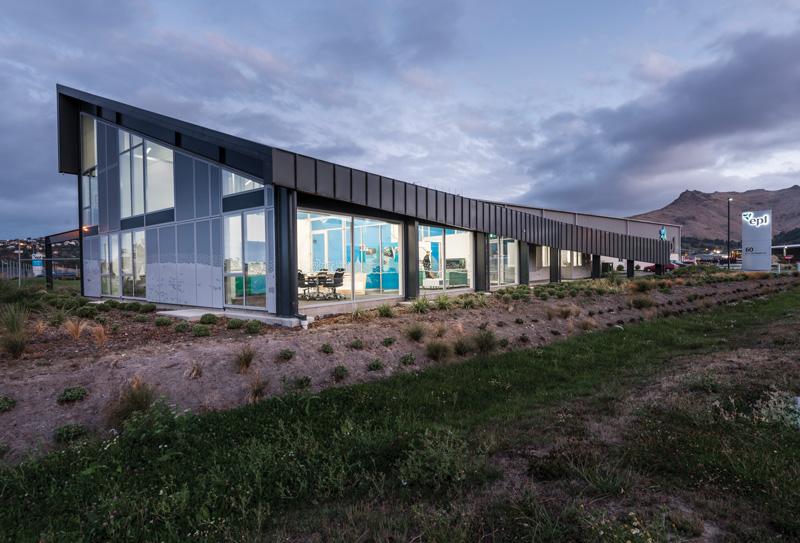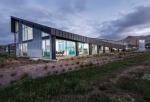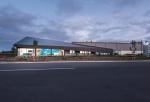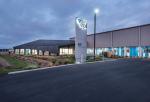EPL Building Christchurch

As a company that makes cutting edge products, EPL wanted a Christchurch head office and manufacturing facility that embodied its drive for innovation.
Elastomer Products Limited (EPL) was founded in Christchurch in 1974 and its extruded rubber and polymer products are used in construction, appliances and electronics, as well as in the marine and medical sectors.
A new building was required after their existing premises were damaged in the Christchurch earthquakes, causing disruption to the business.
Located at the foot of the Port Hills, the firm’s new premises are part of a recently established industrial area linking the port of Lyttelton to Christchurch City.
Last year the EPL building won three regional ADNZ design awards (Commercial/Industrial; Commercial Interior Architectural Design; and Colour in Design) and was a winner nationally in the latter category.
Cymon Allfrey, of Cymon Allfrey Architects, says, “The client wanted the building to embody the innovative elements of their business. While it is a manufacturing facility with areas for research and development, testing and distribution, it is also their head office here and they wanted something relatively unique that epitomised innovation.”
He says the building is comprised of two forms: the understated, gabled, primary industrial building - a steel and pre-cast concrete structure - and the ’twisted’ administration building.
Cymon says the latter is organised by a rhythm of steel portals, each pitched 1.25 degrees steeper than the previous. This allows the roof to gently twist adding to the volume of the building as one moves from the parking area to the main reception space. The roof of the administration building is clad in Calder Stewart Euro-Tray™ providing the tolerance in the sheet joints demanded by the roof twist.
“It’s really a series of straight lines with a slight difference in width between the bottom and top of the tray because there’s enough tolerance in a standard cap that we didn’t need wedge-shaped pans,” says Cymon. “The tolerance that was there – it’s only a few millimetres really – allowed that shape to happen easily. We had string lines set out for each pan so we knew how much creep they would need to get that effect.”
This roof, along with the corresponding dark painted soffit, drapes to create a deliberately cavernous entrance from which subtle changes in height reveal the full volume of the building very slowly, cumulating in the light-filled, two-level reception area to the north.
The remainder of the administration building is clad with painted fibre-cement then wrapped with a powder coated aluminium sheet which has been treated with perforations taken from an image of the neighbouring hillscape. This rain screen detail allows the bold corporate electric blue to be used in a subtle manner.
Cymon says the building planning allows visitors and prospective clients to be welcomed into the commercial office environment and led on operational tours of the site via corridors that navigate the edges of the building allowing an understanding of the process and activity carried out on the site but without entering the highly restricted research and development centre.
The planning of the internal space is largely organised around the 4.5m x 4.5m structural grid creating a generous office proportion. The twisted roof form allows a hierarchy of space to be set up through the variable volume with service and administrative offices to the areas with less volume and senior management, reception, media room and meeting spaces to the greater volume at the northern end.
The internal space is largely finished in an understated palette of neutral tones which act as a canvas for the rear reception wall and the service core finished in the corporate brand ‘electric blue’ and for product and process display within the foyer area.
A long and slender counter of natural finished oak and white acrylic defines the reception. The form of this counter has been crafted as a nod to the extrusion process of the business. These finishes are utilised within the space to decorate other fixtures including the stair and bar area.
Roofing and cladding supplier Calder Stewart says Euro-Tray™ was chosen not only because of the tolerance between the trays but also because it could be manufactured on site, a huge advantage on this job as the sheets were too long for transportation.
Calder Stewart says, “All design is a collaborative effort. A robust discussion was had prior to commencement to be sure the end result was exactly as envisaged by us and the client. When designing something outside of the “normal” way of doing it, you need to take the time and advice from fabricators and installers to ensure that it is done correctly. TM Consultants, who were the structural engineers, also played a fundamental role in achieving the end result.”



